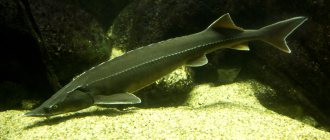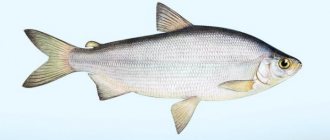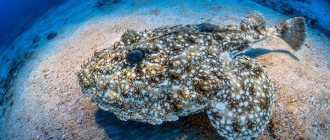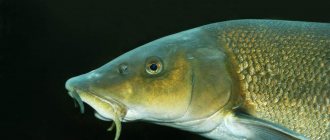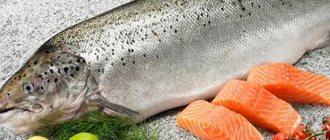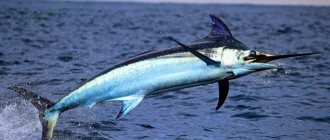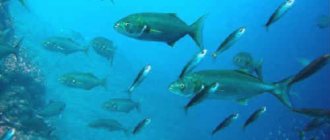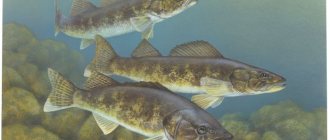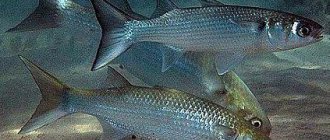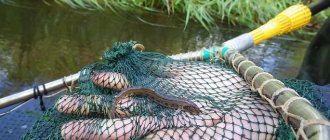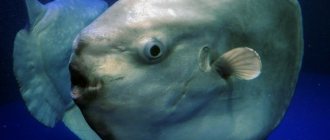Origin of the species and description
The needle family has 298 species. Of the total number, 244 species are needle fish, combined into one subfamily. The remaining 54 species are seahorses.
The length of needle fish can vary and ranges from 2.5 cm to 0.6 m. However, all species are characterized by common features:
- Elongated elongated body.
- The snout is tube-shaped. Its length varies depending on the species.
- A long tail with which the fish can cling to objects and algae.
- Small or absent caudal fin.
- Absence of pelvic fins.
- The pectoral fins serve as the main organ of locomotion. In some species they disappear at a certain age.
The color can be varied: from white to brown. Some species are bright and have contrasting or colored stripes, others are gray with spots. There are species that can change their color in accordance with the external environment.
The family consists of 298 species of fish included in 57 genera
Maintenance and care, arrangement of the aquarium
The optimal size of a tank for 3-4 fish starts from 500 liters, the depth should be at least 30 cm. The design should include dense clusters of plants placed along the walls of the aquarium, thus preserving free areas for swimming.
The lighting is dim. The presence of plants floating on the surface and hanging over the water is welcome. Since they serve as an additional means of shading, in this case it will be necessary to increase the brightness of the light. Other decorative elements and soil are selected at the discretion of the aquarist. A productive filtration system is mandatory when keeping predatory species. In addition to the power of the filter, you should pay attention to what and how the purified water is returned. Depending on the models and types of filters, water is returned in different ways, some create excess flow
In the case of Freshwater Spinefish, internal current should be minimal. High quality water is also maintained by its weekly change (20–30% of volume) and regular removal of organic waste from the surface of the substrate and decorative elements.
Are needlefish and garfish the same thing?
The garfish and needlefish are united only by the common class of ray-finned fish. Almost 95% of all known individuals belong to this category.
The garfish is often called the needlefish, however, people gave it this nickname because of its shape and sharp beak. The similarity with needlefish lies in the elongation of the body and head. All species of garfish have pelvic, pectoral, anal and dorsal fins. The mouth, unlike the needle, has the shape of a beak and is studded with sharp teeth. The garfish family includes several varieties, the sizes of which differ from each other. The largest crocodile species reaches a length of 1.5 m.
Attention!
Unlike pipefish, the predatory garfish does not hunt crustaceans, but small fish: sprat, herring, anchovy, young mackerel and herring. During the hunt, the fish can develop high speed, jump out of the water, and make sharp jerks.
Pipe fish freshwater garfish
Family: Belonidae, Sarganaceae (Belonidae).
Habitat: Lives in estuaries, lakes, canals and other freshwater bodies of India, Thailand, Burma, Ceylon and the Malawian Peninsula.
Water temperature: 22-28.
Aquarium size:
The recommended aquarium volume for 1 adult is from 400 liters.
Life expectancy is about 4 years.
The freshwater needlefish (Xenentodon cancila) has an elongated, cylindrical body, with very long, flattened jaws, which are completely studded with small pointed teeth. The anal and dorsal fins are located at the back of the body and are located in the same vertical line with each other. The ventral and pectoral fins are very small. The main color is silver-green. A horizontal stripe of dark color runs along the entire body. Sexual dimorphism is weakly expressed. In male spiny fish, the anal and dorsal fins have a dark edge.
The surface area of the water plays an important role for the freshwater garfish because it swims in the upper layer of water. The aquarium can be planted with plants, leaving space for swimming between them. The water flow should be kept to a minimum. It is also necessary to have a lid in the aquarium. The needle is an excellent jumper. Lighting in the aquarium should be moderate and sudden changes in light should be avoided. Needle fish are compatible with large catfish and large but non-aggressive cichlids. Small fish will be perceived by the garfish as prey.
When caring for an aquarium, you must be careful, since the fish can bite painfully with its sharp teeth.
Water parameters for keeping needle fish should be as follows: temperature 22-28°C, hardness dH 5-10°, acidity pH 6.5-7.5. Requires enhanced filtration, aeration and weekly replacement of 1/3 of the water with fresh water.
In the biotope, needlefish is an insectivorous predator. In an aquarium, at first, it may refuse non-living (frozen) food. But over time, you can accustom the needle to meat: shrimp, small fish and other frozen food.
Reproduction of pipefish is possible. The freshwater pipefish becomes sexually mature at one year of age. The incentive for spawning is increased feeding with live food and daily water changes. Fish usually spawn in the morning. The eggs are attached to the plants with adhesive threads, the length of which reaches up to 2 cm. The fry appear after 10 days. In the first days of life, the fry are fed small live food and, as they grow, their range is gradually expanded, giving live fry of other fish and finely chopped pieces of frozen fish and shrimp. Food for the fry must be constantly present in the aquarium.
All of the above is just the fruit of observing this type of aquarium fish and collecting various information from owners and breeders. We would like to share with visitors not only information, but also live emotions that allow us to understand the world of aquariums more fully and subtly. Register at https://fanfishka.ru/forum/, participate in discussions on the forum, create profile topics where you will talk about your pets in the first person and from the horse’s mouth, describe their habits, behavior and content, and share with us your successes and joys, share your experiences and learn from the experiences of others. We are interested in every bit of your experience, every second of your joy, every awareness of a mistake, which makes it possible for your comrades to avoid the same mistake. The more of us there are, the more pure and transparent drops of goodness there are in the life and everyday life of our seven billion society.
Needle fish video review
Appearance and features
Let's look at the main characteristics of what an adult pipefish looks like. The body of the fish is elongated, with hard bone thickenings located along its entire length. The mouth is represented by a long “pipe” without teeth.
The color can range from yellow to dark brown. There are species with a reddish and greenish tint, the surface of some of them is covered with spots.
Appearance and habits allow the fish to camouflage itself with environmental conditions. In a static state, with their tail attached to the ground or other surface, the fish resemble algae.
The needle fish has a fairly long body
Types and habitats of garfish
The garfish family includes 25 species. Fish are classified mainly according to the area where they are found.
From a commercial point of view, the most interesting are:
- European garfish (other names: Atlantic, common). The most common species has chosen the moderately warm waters of the Atlantic Ocean, the Mediterranean, Marmara, Black, and Azov Seas (its western, more salty waters). Sometimes common garfish are caught in the White and Barents Seas. The height of adult individuals rarely exceeds 90 cm. Black Sea fish is classified as a separate subspecies. It differs from the European one in its more modest size (up to 60 cm);
- Crocodile garfish (other names: crocodile garfish, giant garfish), the largest representative of the family, growing up to 1.5 meters. The weight of trophy specimens is 6.5–7.5 kg. It lives in the tropical waters of the Pacific and Atlantic oceans. It got its name for its hard scales and its peculiar color, reminiscent of crocodile skin;
- Far Eastern or Pacific gar: distinguished by a narrow bluish longitudinal stripe with a silver tint and the absence of gill rakers; The heat-loving species is most common in the southern waters of the Sea of Japan, off the coast of Korea and China (up to the South China Sea), in the Pacific Ocean south of the island of Hokkaido. In Russia, fish are caught in Primorye. Garfish, as a seasonal migrant in the summer, enter the Peter the Great Bay and the channels of salt lakes in the south of the region. The catches usually contain specimens weighing up to 1 kg and up to 1 m in length. As the water temperature drops to 15° C, it goes south;
- black-tailed gar: an inhabitant of the coastal waters of South Asia received its name for the large black spots on the caudal fin. During low tides, fish often remain in the dry zone, burrowing into the mud or sand to a depth of 50 cm.
Most species prefer to stay close to the coast; some (for example, the tropical ribbon-shaped garfish) go into the open ocean.
There are 5 known species of the garfish family that live in fresh water bodies. They are found in the rivers of South America, Southeast Asia, and Northern Australia.
Character and lifestyle
The pipefish moves smoothly. The tail serves as a support; when stopping, the fish rests it on the ground.
An underwater resident can spend a lot of time hunting. The structure of the body allows you to bend and take unusual poses.
Needles have good eyesight, thanks to which they notice crustaceans hidden in the most secluded places. Large eyes always carefully examine the surroundings.
When prey is detected, the needle freezes, the snout is located not far from the victim. When crustaceans approach, she spreads her gill covers and with a sharp movement of her head instantly sucks in the prey.
Where does it live?
Most pipefish choose warm waters in the coastal zone, where the substrate is sand, often living among algae and corals. Species living in the depths of the sea are rare.
The habitat of most needlefish is the Eastern Atlantic. Common fish are more often found in the Caspian, Baltic, Black, Azov and Aral seas. At the same time, rarer species can be found in coastal zones and fresh water bodies around the world. The needle family is represented by river, brackish-water and sea fish.
Some species live in the lower reaches of rivers. The construction of dams on rivers changes the ichthyofauna, as a result of which needle fish rise up against the current. For this reason, the species has mastered the Middle Volga and rises even higher, penetrating into other rivers.
Habitats
Since the acicular family is quite widespread, it is worth saying in general: as a rule, they prefer the coastal zone of temperate and tropical waters. Although, some representatives are found deep in the Atlantic Ocean. Our most famous subspecies - the long-snouted needle fish - is found everywhere in the Caspian, Black and Azov seas. Although, there have been cases of encounters with them in the Baltic Sea near the Gulf of Finland.
Freshwater species are widely found in the lower reaches of the Volga, as well as in the Kuban and its tributaries.
Kinds
Among the many species of fish, the most common pipefish are:
- serpentine;
- ordinary.
The genus of serpentine needles includes 3 species living in the Eastern Atlantic:
- Worm-shaped pipefish (Nerophis lumbriciformis). The length of females reaches 17 cm, males are 2 cm less. The body is predominantly dark in color, the belly is light (from white to yellow). Pectoral and caudal fins are missing.
- Sea awl (Nerophis ophidion). It is found in aquatic regions from Norway to Morocco (excluding the territory from Denmark to the Netherlands), in the Mediterranean and Black Seas. at a depth of 2-15 m.
- Nerophis maculatus. Western part of the Mediterranean Sea, Adriatic Sea, the coast of Portugal and the Azores. The male reaches a length of 30 cm.
Common pipefish are divided into numerous species, among which the most famous are:
- Long-snouted pipefish. The body length reaches a maximum of 35 cm. The snout is compressed, its height exceeds the diameter of the eyes. Distributed in the Eastern Atlantic (Varde, Norway, the Baltic Sea and the British Isles to Morocco), in addition, it inhabits the entire Mediterranean, Black and Azov Seas. Habitat depth ranges from 1 to 20 m.
- Italian. The length can reach 21 cm. The snout is quite short if you compare the fish with other species. Inhabits vegetative underwater areas from Biscay to Gibraltar, the Mediterranean and Black Seas. Inhabits fresh waters (lower reaches of the Don, Volga, Danube, Dnieper, Western Bug rivers).
- Common pipefish. The maximum length is 50 cm. The color can be from light green to dark brown tones. The cylindrical snout is equal in diameter to the eye, and sometimes smaller than it. Pectoral and anal fins are missing. Found in coastal and estuarine waters at a depth of at least 110 m. Inhabits the Mediterranean, Aegean, and Black Seas. Distributed from Norway to Western Sahara, from Namibia to the Cape of Good Hope.
- Black Sea spiny. Maximum size - 11 cm. More often found at depths of up to 10 m, less often - up to 100 m. Inhabits the Black, Azov and Marmara seas. Found in coastal areas of Turkey. The diameter of the bulging eyes is 2 times the diameter of the snout. The back is grayish-bluish in color with black transverse stripes. The sides and belly are lighter.
- Thin-snouted needlefish. It lives in the southern regions of the Adriatic Sea, in the Tyrrhenian Sea. Less common in the Black and Azov Seas. The depth range is 3-20 m. It can reach 41 cm in length. There are dorsal, pectoral and anal fins. The eyes are small, but their diameter is larger than the snout. The body is rough, the color can vary between light gray or light brown shades.
- Thick-snouted. Inhabits the waters of the Black and Azov Seas. The length can reach up to 36 cm. There are dorsal, pectoral and anal fins. The color changes in light brown, gray and dark brown shades. The snout is long and high.
Longsnout pipefish
Italian pipefish
Common pipefish
Thick-nosed pipefish
Thin-snouted pipefish
Black Sea spiny
Description
Spinefish or spiny fish are a family of fish in the order Stickleback. The family includes more than 250 marine, semi-freshwater and freshwater species. In this article we will talk about needle fish, which is common in the basins of the Black, Azov and Caspian seas.
This species did not get its name in vain - the very flexible and thin long body really resembles a gypsy needle. There are subspecies with a spindle-shaped rounded body and fish with a hexagonal cross-section. It has no scales and is covered with small hexagonal bone plates. It has no fins as such. The caudal peduncle ends in a small “tassel”; on the back and belly, as well as near the gill plates, there are underdeveloped scallops of various sizes.
The head is small and elongated. The mouth has the shape of a tubular stigma. The gill plates protrude strongly to the sides.
Color ranges from clear green to dark brown. The back is always darker and the belly is lighter. The body is covered with transverse stripes that divide the body into visual segments. The dorsal comb is almost transparent without spots.
The needle fish grows slowly and by the age of 6 reaches a length of 17-19 cm. At the same time, the maximum weight it can reach is 0.7 kg.
Care and maintenance
The pipefish moves vertically and requires a lot of space to swim. The volume of the aquarium for it must be at least 150 liters. To observe the birth of fry, you need to purchase a pair. However, babies in aquarium conditions die in most cases. Juveniles are particularly picky about food and feed only on zooplankton.
The fish are peaceful; in the aquarium next door there can be both large and small fish that will not decide to eat the needle.
It is necessary to pay attention to the conditions for live needle food. For a longer life of artemia and nauplii, it is recommended to add one tablespoon of sea salt per 10 liters of water.
Attention!
Species that live in fresh water do not need the addition of sea salt.
There are also more exotic types of needles. For example, Microphis deocata (rainbow freshwater pipefish) lives in clean water bodies of India. The unusualness of the fish lies in the appearance of the males. When meeting a female, their brood pouch opens up like a sail decorated with bright stripes. Under normal conditions, the bursa folds up and looks like a narrow, colored membrane on the abdomen.
The rainbow needle is difficult to transport. In captivity, it is difficult to find suitable conditions for it, so only professionals should purchase this type of fish.
The needle fish is very friendly towards humans and does not consider them an enemy at all.
Water parameters
Experienced aquarists recommend choosing an “old” (long-salted) aquarium.
Optimal parameters for common pipefish:
- temperature - 24-28 degrees;
- density - 1.023-1.028;
- pH - 5-7;
- dH - 5-15.
Acidaceae combines several genera. Environmental conditions for the most popular aquarium species may vary:
- Philippine microphys (Microphis brachyurus). In a community aquarium, they can remain hungry because they eat very, very slowly. pH - 7-8, dGH - 12-18, temperature - 24-28C.
- Large needle (Microphis boaja). Water temperature - 22-26C, salinity - 1-20%.
- African freshwater pipefish (Syngnathus ansorgii). Requires a large amount of vegetation that can comfortably tolerate brackish water. pH - 7-8, dH - 10-25, temperature - 24-28C.
- Syngnathus pulcellus. Salinity - 1-5%, dH 8-15, pH - approximately 7, temperature - 25-28C, in colder water there is a risk of illness.
- Black line pipefish (Syngnathus nigrolineatu). dH 15–30, pH 7–8, temperature - 18-20C (lives in cold water), salinity as required - 1-10%.
Comfortable conditions in the aquarium are created based on the natural habitat of the fish.
Lighting
Too much light causes algae blooms. Darkness and light should alternate, repeating natural living conditions. When the lamp is constantly on, fish feel discomfort and may lose their ability to reproduce. The optimal duration of the photoperiod is 13 hours. For convenience, lighting fixtures with automatic switching on and off are purchased.
The optimal volume of the aquarium is 300 liters
Vegetation
For needles, the presence of lush vegetation is important. In their natural environment, most species choose grassy areas for their habitat.
Note!
Needles feel comfortable if there are several clumps of caulerpa algae or other floating plants in the aquarium.
Pipe fish move slowly and constantly search for various larvae and crustaceans in the ground. They love to hide, so if they provide suitable support, aquarists will be able to enjoy observing the behavior of unusual fish. In a static position, the fish cling to plants and corals with their tails. It is possible to use artificial algae.
Priming
Coarse sand is poured onto the bottom of the aquarium. If it is possible to take soil from its natural habitat, then the fish will quickly adapt to new conditions. Species that live in corals will do better in coral sand.
Decor
To make the needles comfortable in the aquarium, it is necessary to create many spacious shelters in the form of grottoes, stone crevices and corals where the fish can hide. At the bottom you need to install several live stones. In addition to their decorative function, they will become a habitat for various small crustaceans.
It is especially important to have a sufficient number of shelters for fish that are housed with neighbors.
Nutrition
The tube-shaped snout allows it to suck in prey along with the water flow from a distance of 4 cm. In its natural environment, the needlefish feeds on small planktonic crustaceans. The fry, being in the father's pouch, feed from his circulatory system. After separation from the male, they initially feed on zooplankton.
Spinefishes hunt almost all the time. When keeping fish in an aquarium, it is necessary to ensure that cyclops or small daphnia are always in the water. Fish often refuse to eat chopped tubifex.
Aquarists note that in the absence of prey, needlefish quickly lose weight and may die. Difficulties with feeding often arise with fish caught from natural conditions. Fish raised in an aquarium quickly adapt to new food. Over time, they begin to eat highly chopped meat of mussels, shrimp and squid.
Adults prefer fish, frogs, shrimp, tadpoles, nauplii, planktonic crustaceans
Reproduction
The male quickly finds the female and attracts her with a kind of long dance. Eventually, the female wraps herself around the male and deposits her eggs in a leathery pouch on his abdomen. It happens that the caviar is placed in a special groove. For fertilization, the male receives several portions of eggs, 15-20 pieces each. Spawning can last several weeks; in total, one female transfers approximately 100 eggs to the male during the season.
The serpentine pipefish does not have a pouch. The eggs are attached to the male's abdomen and are not protected.
The eggs are kept in the bag until the fry hatch. Often they do not leave the bag for some time. Periodically, the male “walks” his cubs. He bends his body so that the bag can open. However, when danger threatens, the fry return to their father. The eggs receive nutrition from the blood vessels of the father.
Sex differences
Dimorphism in needle fish is weakly expressed. Their appearance is similar; males are often several centimeters shorter than females. The main difference is the structure of the reproductive system.
Males of most species have a special pouch for carrying eggs. Males of some varieties do without such folds and carry eggs on their abdomen. In this case, future offspring are more vulnerable to enemies.
The spawning period for needlefish begins in mid-spring
Bluefish fish: description, habits and industrial significance
Everyone who is interested in sea sport fishing knows who the bluefish is. A photo with this sea beast is direct proof that a person has the right to call himself a fishing master. However, catching her is not so easy. Especially if the fisherman is unfamiliar with its habits and way of life.
Bluefish: description
Bluefish is a marine representative of ray-finned fish, which belong to the order Perciformes. This is a fairly large predator: adult individuals grow more than 1 meter in length, while their weight can reach 15 kilograms. However, such giants are rare today, because bluefish often become victims of fishing.
Now let's talk about the appearance of the fish. This sea creature has a flattened body shape. On its back there are two fins with thin cartilaginous rays. Moreover, the first of them is much sharper, which can be seen even with the naked eye. In addition, there are two pectoral and two pelvic fins, as well as a fork-shaped tail.
The bluefish itself has a dark blue color, with admixtures of greenish scales. The upper part is much darker than the lower part. This color scheme is the main weapon of a sea predator. Thanks to him, he can discourage other fish, which during the escape do not have time to record the maneuvers of their pursuer.
Range and habitat
Many Russian fishermen are confident that only we have bluefish fish. The Black Sea, in truth, is indeed one of the largest havens for this predator, but it is far from the only one. Large populations of this species can be found in the waters of the Indian, Pacific and Atlantic oceans.
In general, bluefish can settle in any sea, provided that the water is warm enough. Therefore, it should not be surprising that fishermen can catch this glorious catch both off the coast of the Black Sea and near the arid regions of Africa.
Habits and lifestyle
Bluefish prefer to lead a school life. Moreover, sometimes the number of such a “family” can reach several thousand individuals. On the one hand, this makes the predator very dangerous for other fish, and on the other, it turns it into easy prey for the nets of fishing vessels.
In addition, bluefish do not like to stay in one place for a long time. Together with his flock, he constantly migrates, sticking to warm waters. During hot periods of the year, it can even go into estuaries or river mouths, but as soon as the temperature drops a little, it returns to the sea again.
Diet and method of hunting
Bluefish is a predator. Due to its size, it can hunt both small and medium-sized fish. For example, its victims can be anchovies, horse mackerel, herring, sardines, anchovy, and so on. In addition, the predator sometimes eats small mollusks that were not hidden from it in time.
In addition, this species is distinguished by its incredible speed of movement. Bursting into schools of other fish, it disperses them in different directions, making them vulnerable to rapid attacks. It is curious that for a long time scientists could not understand how exactly the bluefish catches its prey. This is due to the lightning speed of the fish, which made it impossible to follow it with the naked eye.
Fortunately, modern technologies have helped us see how the Black Sea bluefish hunts. Photos taken at 32 frames per second clearly depict the entire feeding process of the predator.
So, approaching his prey, the hunter opens his mouth and releases air from his gills with all his might - this instantly accelerates him, allowing him to catch his prey in the blink of an eye.
And then all that remains is to quickly chew the prey.
Reproduction and spawning period
Bluefish reach sexual maturity at the age of 2-4 years. Fish spawning takes place only in well-warmed water, and therefore often occurs in July or August. The females lay their eggs directly into the sea, without particularly worrying about their future. Most of the eggs will die or be eaten, but this will not affect the population.
After all, a female can lay up to 1 million eggs at a time, which completely compensates for all possible losses. In addition, the fry is born after 2-3 days, and immediately begins to feed on its own.
Meaning for humans
Bluefish meat is very valuable. This is due to two factors: firstly, it is tasty, and secondly, it contains a small percentage of fat. Because of this, many fishing companies are fishing for this particular species. The largest production of this fish is carried out off the coasts of Australia, Venezuela and Brazil.
In addition, many fishermen organize bluefish fishing competitions. Moreover, similar events are held annually both in our homeland and abroad. Such popularity of the fish is quite justified, because only a skilled and strong fisherman who knows his business can catch it.
Diseases and prevention
It is noted that when transferred from their natural habitat to an aquarium, fish experience stress and require time to adapt. In this case, most individuals develop mucus around the mouth and rear fin, and there is a risk of developing fin rot. The tail may fall off completely, after which it will recover.
After catching fish from reservoirs, they should be placed in a plastic container, gradually begin to aerate it, and fill it with a lot of hornwort, daphnia and cyclops. Very carefully and gradually add 10 drops of brilliant green into the water per 20 liters. This will help eliminate the risk of fin rot.
Water from the pond in which the needlefish lived should be left for a day just in case the fish feels unwell.
Compatibility and natural enemies
Needles are calm and peaceful fish. They feed on small crustaceans and plankton and are not interested in others. They can escape from a predator only through camouflage. Sharing games with predatory and very restless fish is not allowed.
Attention!
Peace-loving species of any size are suitable for living together. In this case, it is better to choose ornamental invertebrates for which needles do not pose any danger.
In their natural habitat, many animals and some insects pose a danger to needles. Aquarists have noticed that an interesting swimming beetle is capturing needlefish and gutting it.
The main causes of disease are poor quality water and feed.
Our regiment has arrived!
Photo SHUTTERSTOCK
The Caspian pipefish is the closest relative of the seahorse. All the differences are that it is straight, but there is the same amount of “fish and meat” in it - five grams. It has no economic significance, but the fish is very interesting.
Nature is rich in miracles. So, in needlefish, the male carries the eggs! Yes Yes. The female lays eggs—about forty eggs—in a leathery sac on the male’s abdomen, which, once filled, is tightly locked from the external environment. By the way, if one female is unable to fill it, then another “lady of the heart” can add to the norm. Next, the male experiences all the delights, in the full sense, of pregnancy. Saturation of eggs, hatched larvae and fry that develop from them with oxygen. Removal of waste products from the brood cavity is ensured by the male’s circulatory system. The fry are released into the natural environment only when they reach the ability to feed independently.
It is also noteworthy: against the well-known general background of a decline in both the actual number of populations and the diversity of biological species on the planet, the number of Caspian needle fish is growing. Moreover, the natural habitat of its freshwater form in the Volga and Ural deltas has begun to actively spread to the north in recent decades. Upstream of these rivers and adjacent reservoirs. Volgograd Reservoir, Saratov...
Just when the chairman of the board of the hunting society, Frat Khabibov, and I were poking around on the Internet in search of information, Valera Ablyazov stopped by: “Well, yes, it’s been found on the Nizhnekamsk reservoir for about fifteen years now.” If not sooner.
What was supposed to happen happened. This year, 2021, in our Oktyabrsky hunting area, in the Mullinsky quarries, Mukhamet Mustafin, accidentally hooking a jig, fished out this very needle. Thus, our fish shelf has arrived. From now on, the Caspian needle fish can also be added to the existing long list of inhabitants of our reservoirs. But that’s not all... Over the last couple of years, rumors have begun to circulate about the appearance of rotan in the immediate area. A year or a little more ago, Sergei Vaneev caught a rotan in the Kidash River. Dried specimens of rotan and needles are now stored in the hunting society. So to speak, as material evidence.
Rotan is said to have been brought to European Russia from the Far East. From the shores of the Pacific Ocean, that is. Who brought it from there and why is unknown and, as a result, incomprehensible. We only know that the Pacific Ocean and the continental water system “attached” to it are definitely the farthest from our western Cis-Urals in every sense. And it’s just far away, and has no direct connection with the Volga-Caspian basin. And rotan - here it is! That is, our regiment arrived twice, but here, it seems, we need to think about it.
Despite the fact that the needle fish has no significance for the human “table” and fishing passion, I would still welcome it. Some of our fishermen, Rustam Mardinshin in particular, caught catfish in the Kama and Belaya, whose stomachs were filled with needles. This means that, being the main food for some predators, it contributes to the development of the population of all present fish species. Moreover, the needle feeds, although regularly, but little. It feeds on the smallest phyto- and zooplankton. In any case, we do not yet know about any negative consequences from the introduction of the Caspian needle fish to “us”.
In turn, rotan can reach a weight of eight hundred grams and is always caught. At any time of the year and in any weather. This, you see, is good for every fisherman. It would seem that! Rotan is an incredibly voracious predator. It is capable of eating everything that is slightly smaller than itself, and ultimately reduce groups of other fish, especially in closed reservoirs, to zero. And no one needs this anymore.
As far as I understand, no one now has any idea how to “deport” this “migrant from the east.” And what other consequences may arise from his presence, apparently, too. And yet, it’s not superfluous to be interested in the world’s oceans, and indeed in all wild nature. The most interesting discoveries are being discovered...
Gennady Agapitov June 20, 2021 at 02:47 pm
Population and species status
Needlefish have no commercial value for humans; they are used as souvenir fishing objects. Lack of catching does not affect the decline in fish populations.
Some species are vulnerable to adverse environmental conditions. Thus, thick-snouted and thin-snouted needlefish are included in the Red Book of Ukraine and have the status “Vulnerable”. The reason is water pollution.
To preserve fish with this status, fishing is prohibited, and a reserve regime has been established in the discovered habitats.
Reviews
Pipefish are relatives of seahorses. They are similar in structure, but differ in their elongated long body. The species is widespread in marine coastal areas and freshwater bodies. Needles are heat-loving fish, so lowering the temperature in the aquarium below 24 degrees negatively affects their health. It is better for novice aquarists to choose local species of needlefish, for which it is not difficult to replicate the natural conditions of their habitat in captivity.
Would you like to purchase an Igloo Fish for your own aquarium? Share in the comments!
